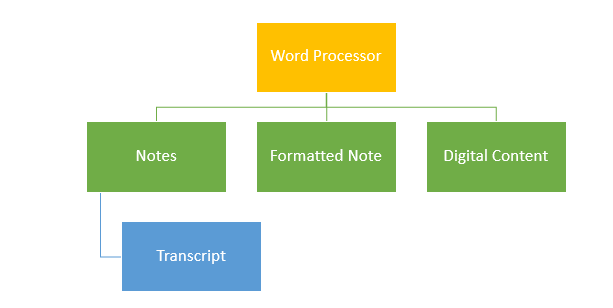Generics feature is template kind of implementation approach, which allow us to define classes, methods and properties which are accessible using different data types and keep a check of the compile-time type safety.
A generic type is a class or function that is parameterized over types. We always use angle brackets (<>) to specify the type parameter in the program.
Pros:
Compile time safety: Generics code is checked at compile time for the parameterized type so that it avoids run time error
Type casting: No need to typecast the object.
Type safety: Generic allows only single type of object at a time.
If you ever defined generic in Kotlin, you’ll notice many a times, it would propose to use the in or out keyword to define the generic. It puzzles me at a start on when which is used, and for what.
Formally, this is a way to define Covariant & Contravariance. Let’s see with the example in simple Word Processing and its implementation on Consumer (User) & Producer (Output Mode).
Out (Covariant): If your generic class/interface only use the generic type as output of its function/s, it won't allow us to add the setter function with T
interface ProduceOutput<out T> { fun getContent(): T }
interface ConsumeInput<in T> { fun consumeContent(data: T) }
open class WordProcessor(val content: String, val isStyle: Boolean = false, val isAnimated: Boolean = false) { fun show() { println("Type : $content | Style: $isStyle | Animation: $isAnimated") } fun showConsumer() { println("Input : $content | Style: $isStyle | Animation: $isAnimated") } } open class Notes(input: String) : WordProcessor(input) class Transcript(input: String) : Notes(input) class FormattedNote(input: String) : WordProcessor(input, true) class DigitalContent(input: String) : WordProcessor(input, true, true)
class GeneralProcessing : ProduceOutput<WordProcessor> { override fun getContent(): WordProcessor { return WordProcessor("Content Processor General") } } class Notepad : ProduceOutput<Notes> { override fun getContent(): Notes { return Notes("Notepad Content") } } class MSWord : ProduceOutput<FormattedNote> { override fun getContent(): FormattedNote { return FormattedNote("Formatted Content") } } class Flash : ProduceOutput<DigitalContent> { override fun getContent(): DigitalContent { return DigitalContent("Graphic Content") } } class SubEditPlayer : ProduceOutput<Transcript> { override fun getContent(): Transcript { return Transcript("Subtitle Content") } }
/*out -- This subtype class will be assigned only to the same type or super type class*/ val meetingMinutes: ProduceOutput<WordProcessor> = Notepad() val wallPoster: ProduceOutput<WordProcessor> = MSWord() val flashGame: ProduceOutput<WordProcessor> = Flash() val osDefaultDoc: ProduceOutput<WordProcessor> = GeneralProcessing() val youtubeSubtitle: ProduceOutput<Transcript> = SubEditPlayer() // Eg: out compiler error // val meetingRecording:ProduceOutput<DigitalContent> = GeneralProcessing() // Error // val poster:ProduceOutput<Notepad> = GeneralProcessing() //Error val twoDGame: ProduceOutput<DigitalContent> = Flash() // This works - Same Class Type val subTile: ProduceOutput<WordProcessor> = SubEditPlayer() // This works -- subtype assigned to supertype meetingMinutes.getContent().show() wallPoster.getContent().show() flashGame.getContent().show() osDefaultDoc.getContent().show() youtubeSubtitle.getContent().show() twoDGame.getContent().show() subTile.getContent().show()
class GeneralReviewer : ConsumeInput<WordProcessor> { override fun consumeContent(data: WordProcessor) { println("GeneralReviewer -- Review the content") data.showConsumer() } } class Reporter : ConsumeInput<Notes> { override fun consumeContent(data: Notes) { println("Reporter - Taken Rough Notes") data.showConsumer() } } class ContentDesigner : ConsumeInput<FormattedNote> { override fun consumeContent(data: FormattedNote) { println("Designer - Formatted the content") data.showConsumer() } } class GraphicDesigner : ConsumeInput<DigitalContent> { override fun consumeContent(data: DigitalContent) { println("Graphic Designer -- Added Animation Effects to the content") data.showConsumer() } } class SubtitleWriter : ConsumeInput<Transcript> { override fun consumeContent(data: Transcript) { println("Subtitle Writer -- Updated subtitle content") data.showConsumer() } }
/*in -- This supertype class will be assigned only to the same type or subtype class*/ val takeNotes: ConsumeInput<Notes> = Reporter() val pageMaker: ConsumeInput<FormattedNote> = ContentDesigner() val adFilm: ConsumeInput<DigitalContent> = GraphicDesigner() val generalContent: ConsumeInput<WordProcessor> = GeneralReviewer() val subTag: ConsumeInput<Transcript> = SubtitleWriter() // Eg: in compiler error // val takeNotes2: ConsumeInput<WordProcessor> = Reporter() // Error // val pageMaker2: ConsumeInput<WordProcessor> = ContentDesigner() // Error // val adFilm2: ConsumeInput<WordProcessor> = GraphicDesigner() // Error // val tagline: ConsumeInput<WordProcessor> = SubtitleWriter() // Error val generalContent2: ConsumeInput<WordProcessor> = GeneralReviewer() // No Error Same Type val subTag2: ConsumeInput<Transcript> = GeneralReviewer() // No Error -- supertype assigned to subtype takeNotes.consumeContent(Notes("Hello, Welcome to meeting")) pageMaker.consumeContent(FormattedNote("Thank you all")) adFilm.consumeContent(DigitalContent("BGM Rocks")) generalContent.consumeContent(WordProcessor("Great to review")) generalContent2.consumeContent(WordProcessor("GeneralContent2: Great to review")) subTag.consumeContent(Transcript("Display at the bottom")) subTag2.consumeContent(Transcript("Subtag 2: Display at the bottom"))




